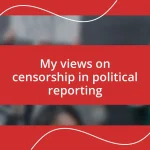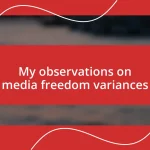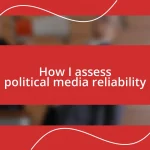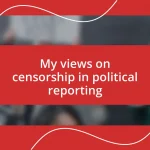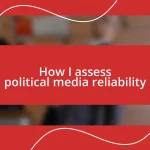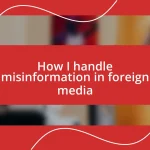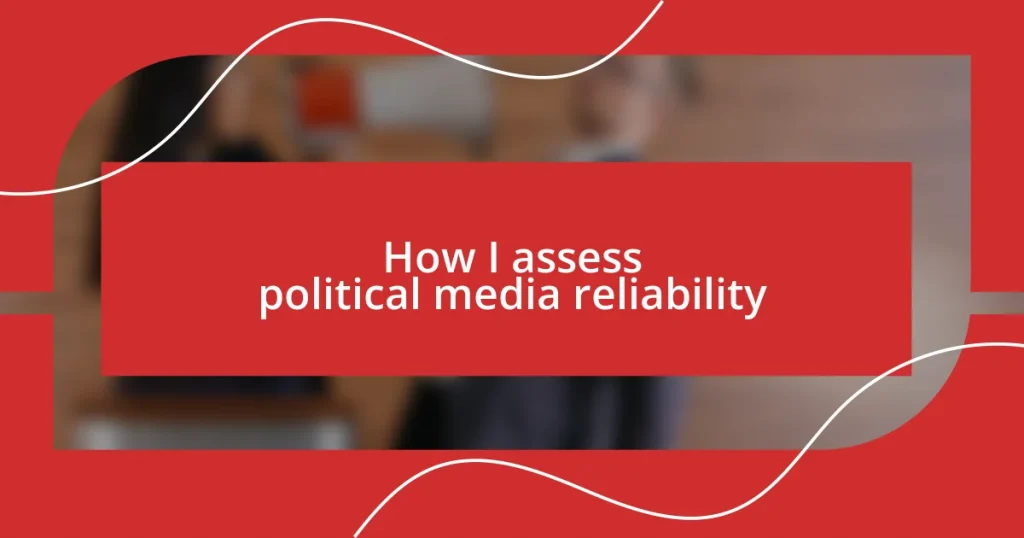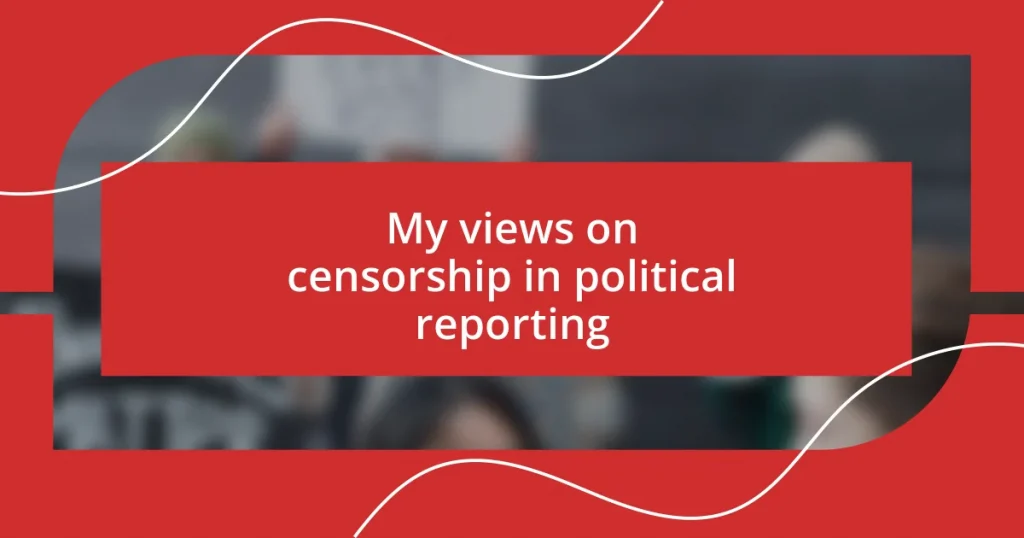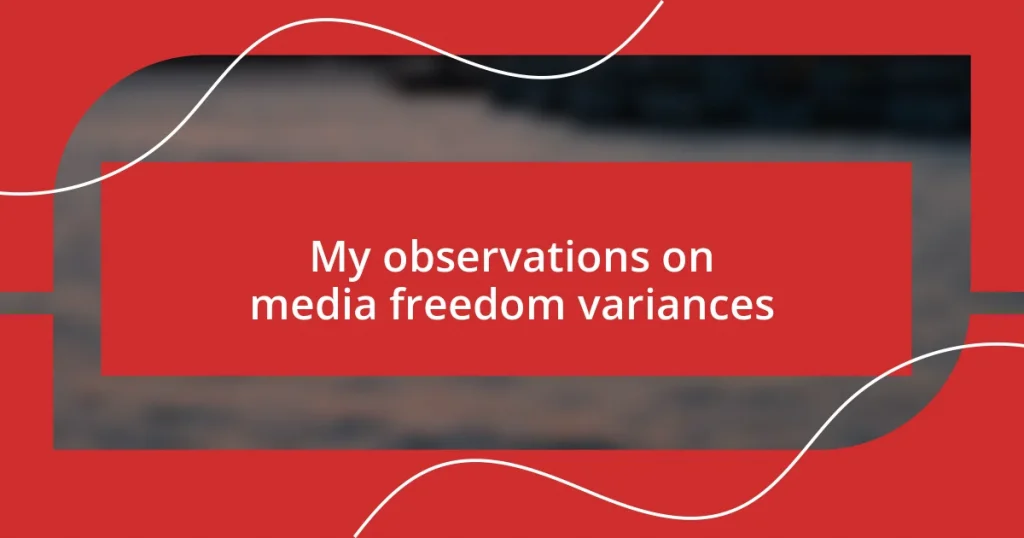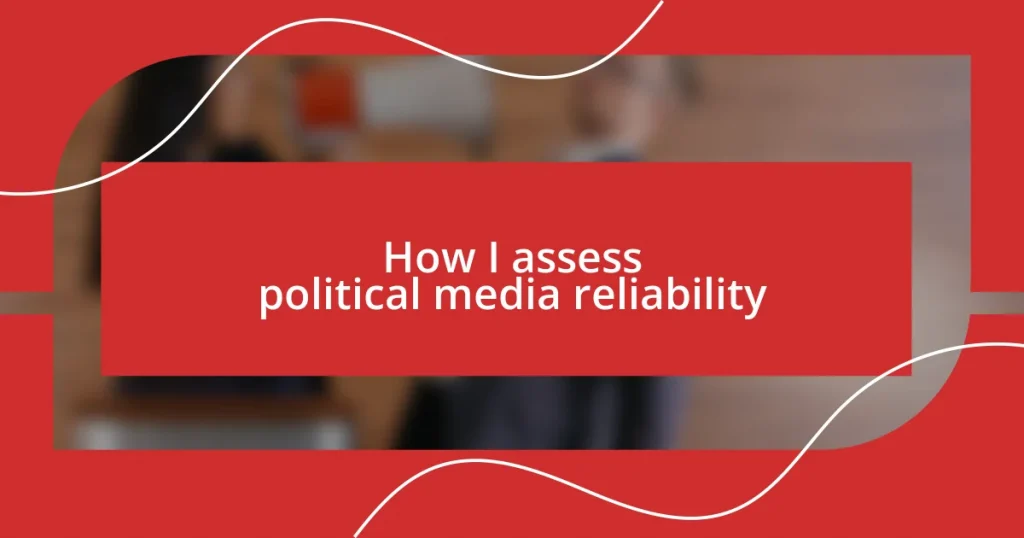Key takeaways:
- Recognizing bias and the importance of seeking diverse viewpoints is crucial for a balanced understanding of political media.
- Evaluating source transparency, including funding and editorial guidelines, significantly impacts trust in media reliability.
- Developing a personal assessment framework fosters critical engagement with media, combining criteria awareness and intuitive skepticism.
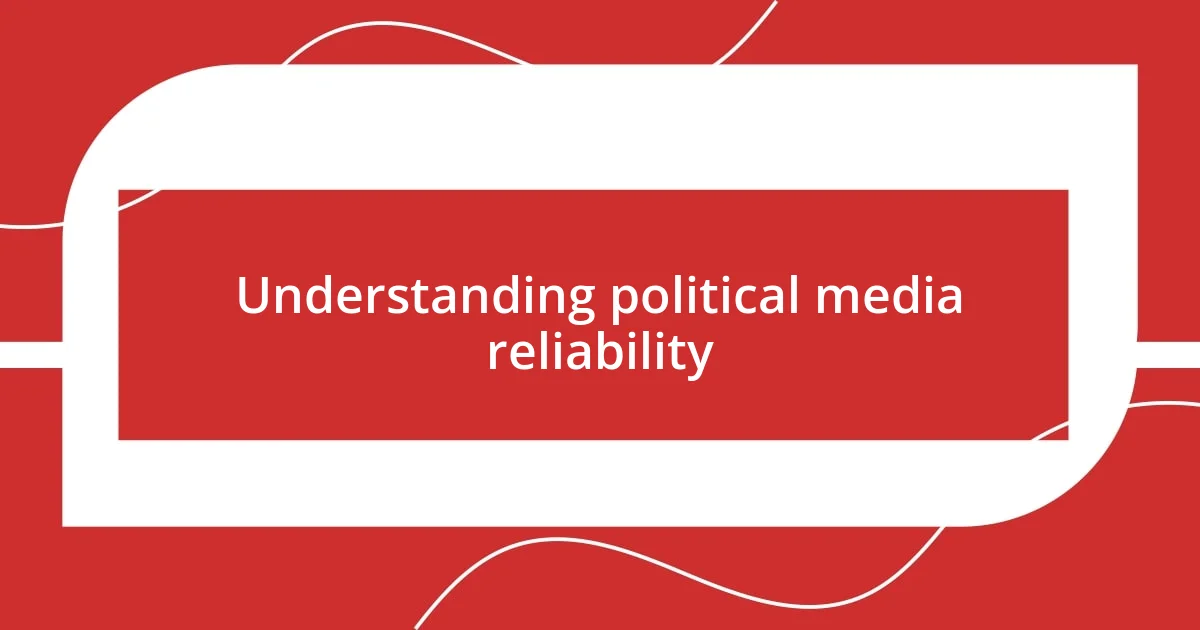
Understanding political media reliability
When exploring political media reliability, I often find myself reflecting on the sources I choose to engage with. I remember a time when I came across a sensational headline that promised to unveil a scandal. Initially, I felt a surge of excitement, but as I delved deeper, I realized the claims were unsupported by credible evidence. It made me question: How often do we chase sensational stories without verifying the facts?
Understanding political media reliability also involves a recognition of bias. I once followed a news outlet that consistently aligned with my views, thinking I was well-informed. However, I later discovered how that skewed perspective limited my understanding. Have you ever found yourself in a similar situation? It’s a humbling experience that highlights the importance of seeking out diverse viewpoints to form a more balanced perspective.
Moreover, I’ve learned to assess the credibility of sources by examining their track record. For instance, when I read an article, I look for transparency about funding and editorial standards. This critical eye has led me to useful insights that I would have otherwise missed. Isn’t it surprising how much a little scrutiny can reveal about the reliability of what we consume?
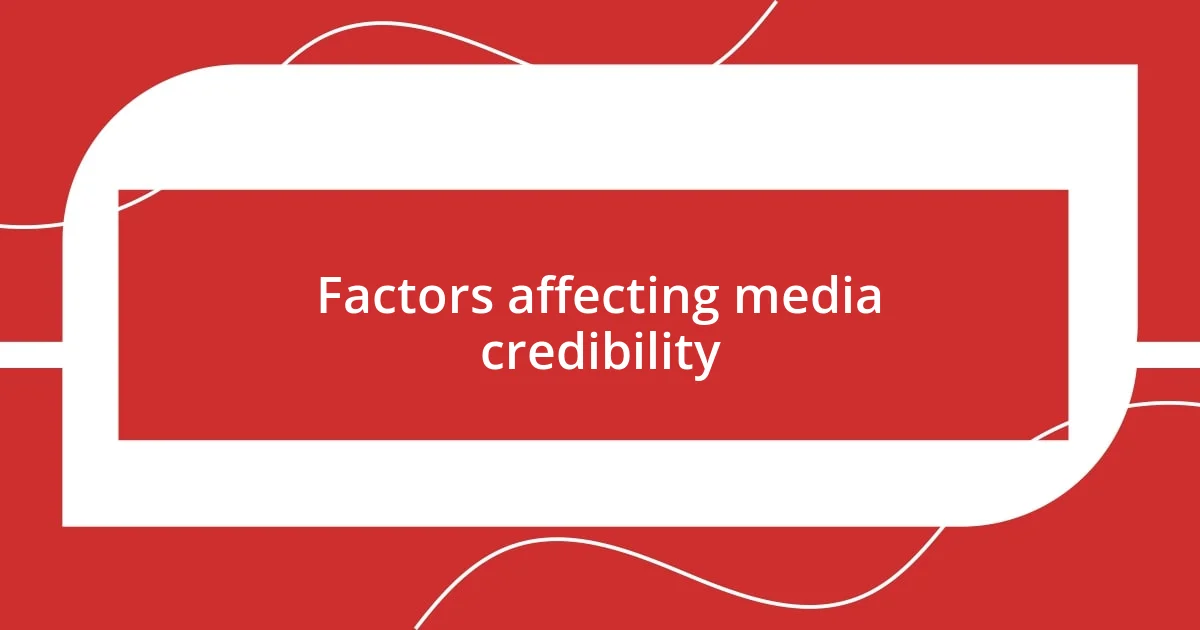
Factors affecting media credibility
When evaluating media credibility, I often reflect on the experience of recognizing specific biases in reporting. There was an instance where I read an article that was so skewed in its presentation of facts that it left me feeling manipulated. It struck me how vital it is to identify the underlying motivations of media outlets; whether they are promoting an agenda or simply reporting unbiased information can deeply impact our understanding of the news.
Several key factors contribute to media credibility:
– Source Reputation: Established outlets with a history of accuracy typically have more credibility.
– Fact-Checking Practices: Media that prioritizes verification of information before publishing tends to be more trustworthy.
– Transparency: Outlets that disclose their funding sources and editorial guidelines allow for greater scrutiny by the audience.
– Bias Awareness: Recognizing if the media outlet leans towards a particular political or ideological slant can influence how I interpret their information.
– Accurate Citations: Articles that provide clear references to studies or expert quotes enhance their reliability.
The continual assessment of these aspects keeps me grounded, ensuring I remain well-informed rather than swept away by sensationalism. It’s fascinating to realize how much our perception is influenced by these factors, and I strive to share this understanding with others to foster a more critical engagement with the news we consume.
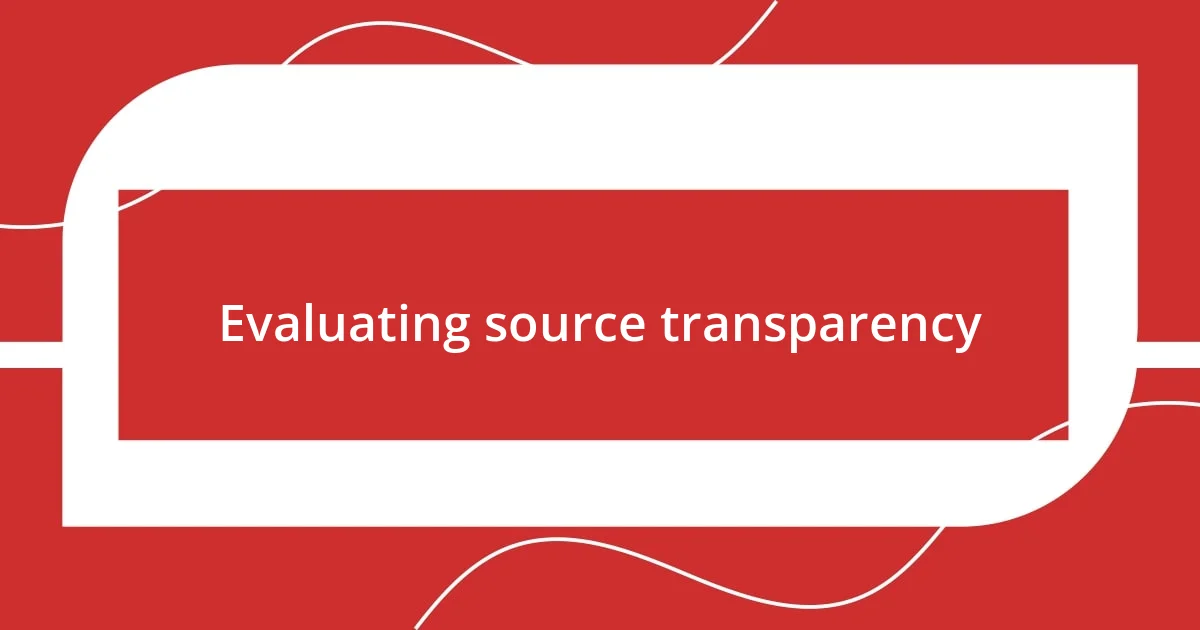
Evaluating source transparency
Evaluating source transparency is crucial to understanding the reliability of the media we consume. I still remember a particular article I read that seemed to come from nowhere, filled with dramatic claims but lacking any clear indication of who funded it or what editorial policies were in place. That left me questioning: If the source isn’t open about its background, can we truly trust what it presents? It’s a gut feeling that I now pay attention to whenever I encounter new media.
In my experience, it’s often the transparency in a source that reveals its integrity. I recall a time when I stumbled across a news outlet that proudly displayed its funding sources and editorial guidelines right on the homepage. It was refreshing. This kind of openness not only inspires confidence but helps me critically assess the information presented. I often wonder how many people overlook this key aspect—wouldn’t it change our feelings toward a news piece if we knew exactly who was behind it?
To give some clarity, I like to compare various sources based on their transparency. Here’s a quick table I put together to illustrate how different outlets handle this important aspect.
| Source Name | Transparency Level |
|---|---|
| Source A | High (clear funding & editorial guidelines) |
| Source B | Medium (some financial disclosures) |
| Source C | Low (no disclosure of funding sources) |
By evaluating sources this way, I’m able to navigate the waters of political media more effectively. It’s an enlightening exercise that has typically led to a better understanding of the narratives that shape our world.
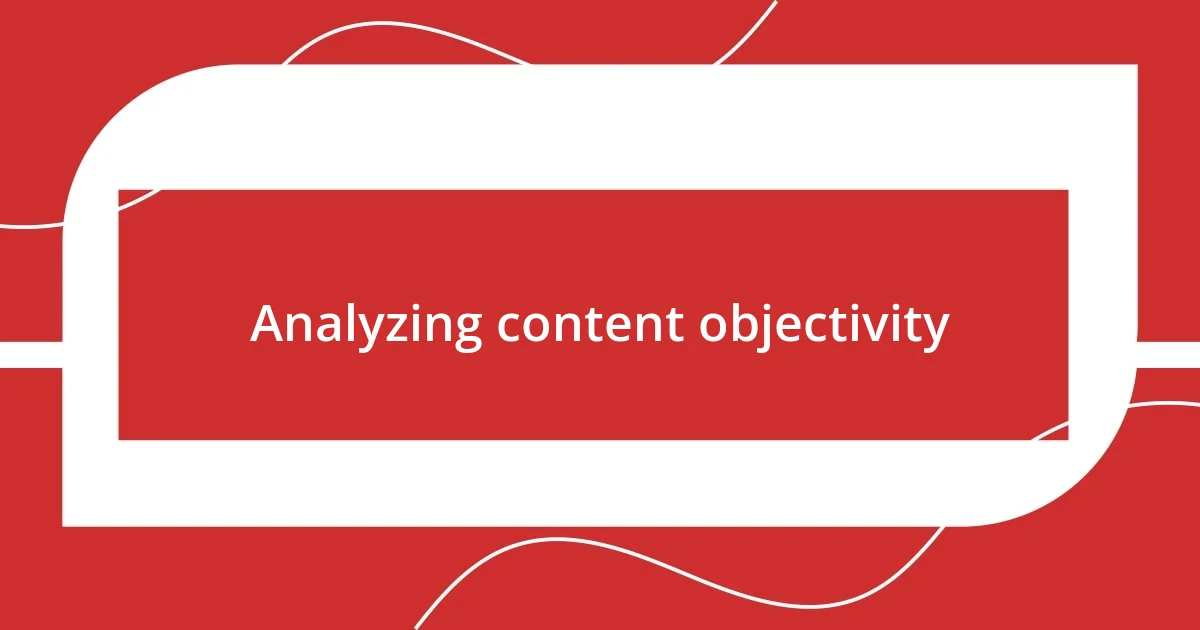
Analyzing content objectivity
When I analyze content objectivity, I often look for the presence of balanced perspectives. One day, I came across a piece that boldly claimed one political figure was the sole reason for a major policy failure. I couldn’t help but wonder, isn’t it critical to consider other contributing factors, too? This moment reinforced for me how essential it is to seek out articles that acknowledge multiple viewpoints, as it enriches my understanding and helps to form a more rounded opinion.
Another aspect I focus on is the use of emotionally charged language. I recall reading an op-ed that utilized dramatic phrasing to describe a situation, making me feel more like I was reading a script for a movie than a serious analysis of a political issue. It left me questioning: is the goal here to inform, or to incite? That experience taught me to be wary of content where the language leans more towards sensationalism than factual reporting.
I also pay attention to how well the article supports its claims with data and evidence. I remember a long-form article I found particularly compelling because it backed up its assertions with comprehensive research and cited reputable sources. This kind of grounding in facts engages me as a reader and establishes a solid foundation for the arguments presented. Have you ever felt more convinced by a piece simply because it backed its claims with data? It’s a powerful reminder of how information should be presented to facilitate understanding instead of persuasion.
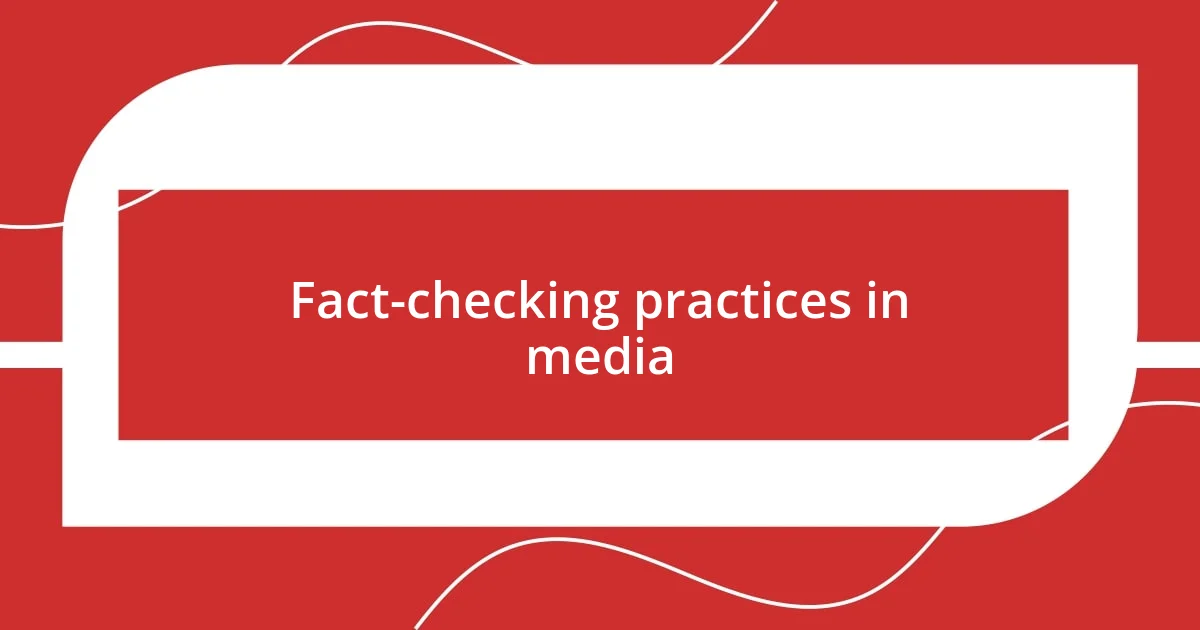
Fact-checking practices in media
Fact-checking has become an essential practice in the media landscape today. I vividly remember a news segment where several claims were made about a new law, and within moments, fact-checkers had debunked several of them live on air. It was refreshing to see that commitment to accuracy, and it made me reflect on how often I take for granted the reliability of the information presented to me. Have you ever felt that exhilarating sense of clarity after a fact-check confirmed or refuted a story?
In my experience, reputable media outlets often employ teams dedicated explicitly to fact-checking. I once read a report from a well-known organization that had followed the entire legislative process of a controversial policy. They not only presented the facts but also transparently detailed how they verified the claims made by politicians and activists. This process made the information so much more digestible for me, and I found myself nodding in agreement as I absorbed the details. It’s fascinating to think: how much more can we trust a source when we know there’s a robust fact-checking system in place?
That said, the effectiveness and transparency of fact-checking can vary significantly. I recall a time when I stumbled upon an online platform that claimed to fact-check statements from various public figures. But as I scrolled through their data, the methodology used seemed vague at best. I couldn’t help but question how reliable their assessments were. Isn’t it amusing how the quest for truth can sometimes lead us down a rabbit hole of uncertainty? Understanding the processes behind fact-checking helps me sift through the clamor of opinions and claims.
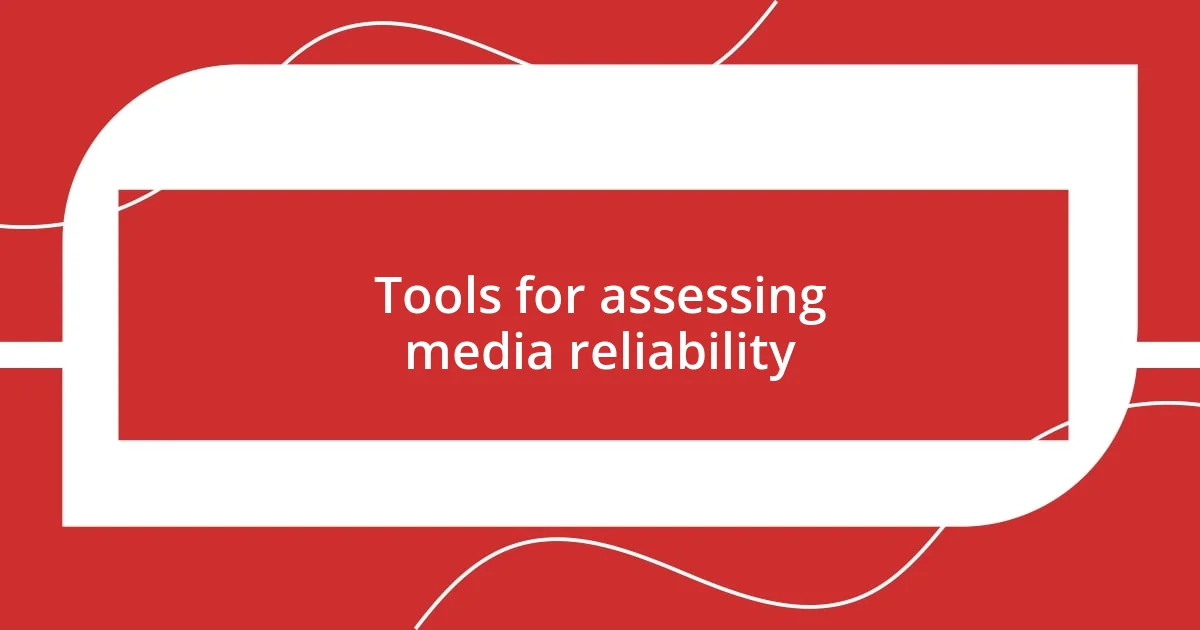
Tools for assessing media reliability
When it comes to assessing media reliability, I’ve found that specific tools can enhance my analysis significantly. One day, I decided to use a website dedicated to verifying the credibility of news sources. I remember feeling a sense of empowerment as I navigated through ratings and reviews, each assessment clarifying why some outlets were considered more trustworthy than others. Have you ever experienced that moment of revelation when you discover a tool that crystallizes your understanding of a complex issue? It’s like finding a compass in an unclear landscape.
Another tool I regularly use is the reverse image search feature. I stumbled upon it while investigating a viral photo that claimed to show a shocking political rally. Running the image through this tool revealed that it was actually from years prior, connected to an entirely different event. This experience taught me the potency of visuals in media and how easily they can mislead if taken at face value. Isn’t it fascinating how a single image can alter our perception, making critical thinking essential in our media consumption?
I also appreciate social media analytics tools for gauging the engagement and sentiment surrounding particular stories. I recall tracking the data on a controversial topic that sparked divisive opinions online. The analytics showcased not just the volume of shares but also the emotional tone intertwined with each post. This collection of insights deepened my understanding of public perception. Have you ever noticed how the public’s emotional response can dramatically shape the narrative, sometimes more than the facts themselves? It’s a reminder that in a digital age, numbers can tell powerful stories about how we process information.
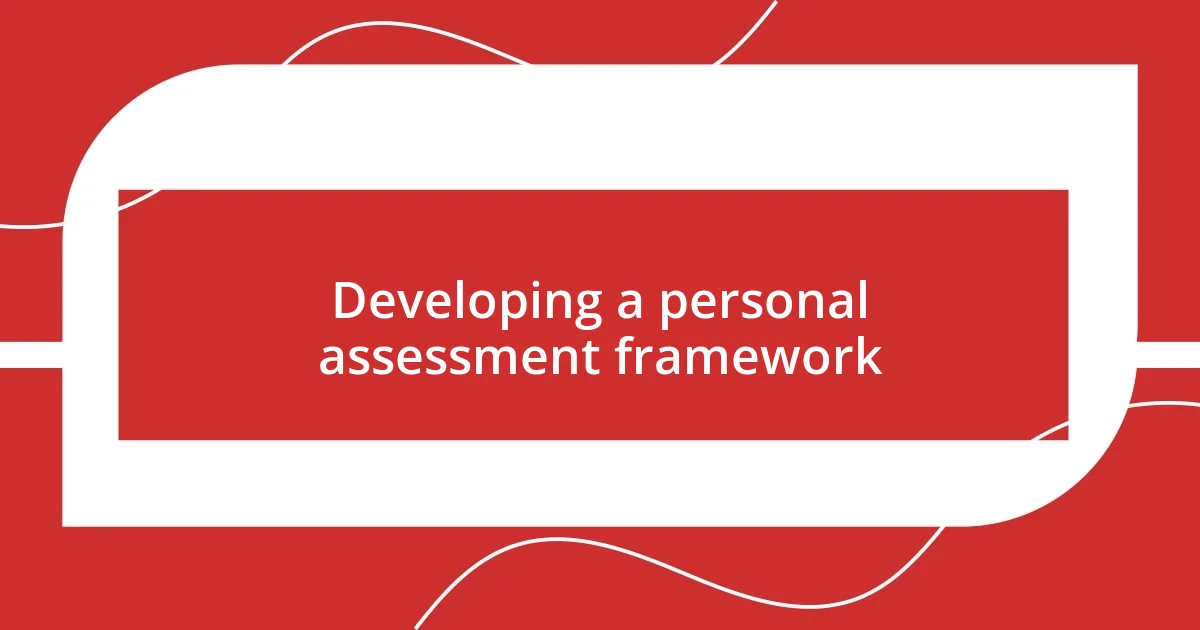
Developing a personal assessment framework
Creating a personal assessment framework for evaluating political media is like building a toolbox tailored to my needs. I often begin by identifying key criteria that matter most to me, such as source credibility, editorial standards, and bias. For instance, I remember when I discovered that a specific publication had a history of sensationalist headlines, and it prompted me to rethink how frequently I relied on their stories. Isn’t it interesting how just one piece of information can entirely alter your trust in a source?
Beyond establishing criteria, I find it crucial to stay updated on current media literacy initiatives. I once participated in a workshop that focused on recognizing misinformation and that experience unlocked a whole new perspective for me. It made analyzing sources less about a static checkbox and more about dynamic engagement with content. Have you ever thought about how evolving your understanding of media can actually enhance your critical thinking skills in real-time?
Ultimately, I think the most essential part of my assessment framework is developing an intuition about media narratives. I recall a moment when I encountered a sensational claim about a political event; my gut told me something felt off. Delving deeper, I discovered it was based on a single, unreliable source. This experience reinforced my belief that cultivating a sense of skepticism can be just as powerful as the guidelines I create. How much more discerning can we become when we learn to trust our instincts alongside our frameworks?
